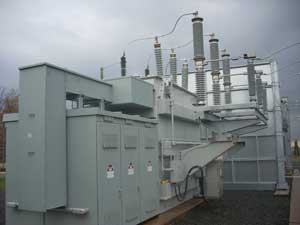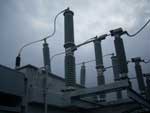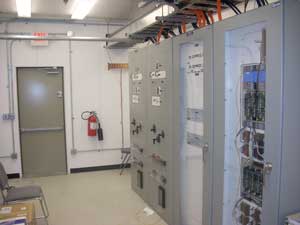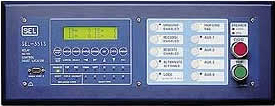
General Information
The
City has 6 substations located throughout the city. The image above is
one of the four transformers that provides electric power to the
largest customer, Micron Technology. Although the transformer itself
(located just in front of the wall) is a typical transformer that the
City would use, the gear attached to the opposite end referred to as
switchgear, is not found in any of the other facilities. Use the menu
to the left to read more detailed information about the topics below.
Transformers
Transformers
such as the one above tranform one elctric voltage into another. In
this example the input voltage is 115,000 Volts and the output voltage
is generally around 7,800 volts. Two of the stations in Manassas have
230,000 volt inputs.
 The
large stacked cylinder objects on top of the transformer (pictured
left) are called insulators. They are required to keep the incoming
electric lines far enough away from other metal surfaces that are
grounded. If proper clearances are not maintained, there would be
enough electrical potential for the electric to "jump" to the metal or
grounded surface and cause a fault and a lot of damage.
The
large stacked cylinder objects on top of the transformer (pictured
left) are called insulators. They are required to keep the incoming
electric lines far enough away from other metal surfaces that are
grounded. If proper clearances are not maintained, there would be
enough electrical potential for the electric to "jump" to the metal or
grounded surface and cause a fault and a lot of damage.
Control House
 The
image to the left of a control house in a substation. If you read
through and of the SCADA information pages, you will notice that the
SCADA equipment, or RTU, is located in the last section to the right in
the picture. The control house is the manual interface for the
substation. A technician or lineman can control circuit breakers (open
and close) or place them in different operating modes. In addition, it
generally houses all of the protective gear for all of the electrical
equipment.
The
image to the left of a control house in a substation. If you read
through and of the SCADA information pages, you will notice that the
SCADA equipment, or RTU, is located in the last section to the right in
the picture. The control house is the manual interface for the
substation. A technician or lineman can control circuit breakers (open
and close) or place them in different operating modes. In addition, it
generally houses all of the protective gear for all of the electrical
equipment.
Protection
 The
image to the left is an electronic processor based protective relay.
These devices are responsible for ensuring the safety of personnel
working on equipment and for the safety of the general public. If a
tree falls on an energized line a device such as this one will trip the
circuit breaker. Although it is actually much more sophisticated than
that, you could compare it to a circuit breaker in a home. If you
overload your electrical outlets in your house, a circuit breaker or
fuse will blow in your electrical panel.
The
image to the left is an electronic processor based protective relay.
These devices are responsible for ensuring the safety of personnel
working on equipment and for the safety of the general public. If a
tree falls on an energized line a device such as this one will trip the
circuit breaker. Although it is actually much more sophisticated than
that, you could compare it to a circuit breaker in a home. If you
overload your electrical outlets in your house, a circuit breaker or
fuse will blow in your electrical panel.



